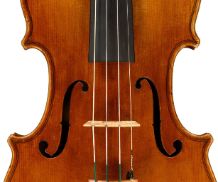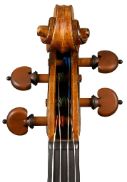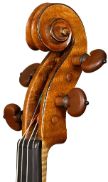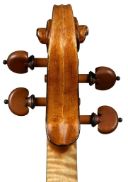Violin, Giovanni Battista Guadagnini, Turin, 1776, “ex Beare-ex Tetzlaff”
Printed label: “Joannes Baptista Guadagnini / Cremonensis fecit Taurini. 1776 [cross]” (1776 handwritten)This instrument is a characteristic example of Guadagnini’s work in his last period in Turin. As his violin labels indicate, Guadagnini set great store by displaying a connection to Cremona even though no records show that he had come from, or trained in, Cremona. Nevertheless, the 1776 violin is very obviously based on the style of Cremonese master Stradivari. The body model and other construction details, such as the blackened pegbox and scroll chamfer, clearly reflect Stradivari’s influence. The belly is made of spruce with very regular growth, showing medium-wide annual rings on the treble side and broad rings on the bass side. The two halves of the belly are not from the same log. A dendrochronological analysis set the youngest tree ring at 1770, revealing that only a few years had passed between felling the tree and building the instrument. The high correlation with other Guadagnini instruments from the period after 1770 is noteworthy. The divided, quarter-cut maple back is very attractively figured with a tight flame that slopes downward from the center to the edge on either side. The ribs, too, are closely flamed. By contrast, the pegbox and volute are only faintly flamed. The fluting and arching are consistent with those of instruments from Stradivari’s Golden Period. Guadagnini followed his own style in crafting the f-holes, though: They are positioned somewhat higher in the body than those of Stradivari’s instruments, with the treble-side f-hole positioned a few millimeters higher than the f-hole on the bass side. Stradivari used to blacken the chamfers of the pegboxes and scrolls of many of the instruments he built after 1688 to give them a more sculptural appearance, and many copyists followed this stylistic example. Guadagnini, too, expressed his closeness to the master luthier in this way. The violin has an intensely lustrous, deep-red varnish. The instrument is in excellent overall condition. Its provenance can be traced as far back as 1916, when it was held in the Beare collection in London. Subsequently, it was sold to a private individual in England. In 1994, German violinist Christian Tetzlaff purchased the violin.












